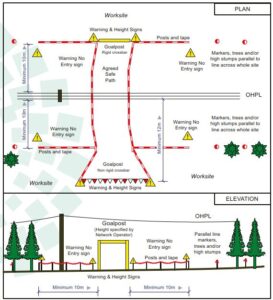The Euro football championships are in full swing and we have had two reports in recent weeks of damage to goal posts from passing machinery, so it seemed a good opportunity to remind ourselves of the requirements for goal posts
For clarity jumpers are not sufficient in either a forest or European Championship context!
The HSE guidance document that addresses overhead powerlines is called
“Avoiding danger from overhead power lines” and has the reference number GS6. This is why network operators refer to measuring the height of lines as a GS6.
In forestry we also have FISA 804 Electricity at Work: Forestry.
In both of these documents planning is the key factor. The first step in risk management is to eliminate the risk.
- Can passing under overhead lines be avoided?
- Where it can’t be avoided it leaves us having to manage the risk. This is best done by planning to minimise the number of times we have to pass under the overhead power lines and controlling how and where we do so.
The accepted approach to this is the use of goal posts and warning signs stating the height of the goal post. The height is set by the network operator after they have measured the height of the line and allowed the appropriate safety distance. This varies based on voltage and must only be measured by the network operator.
The goal posts won’t stop a vehicle or machine hitting an overhead powerline, but act as visual reminder and height check to help reduce the risk significantly. There is no standard construction for goal posts, but wherever possible they should have a solid cross bar. Only where the span is too wide for a solid cross bar should rope and bunting combined be used.
How ever the goal posts are constructed they must be inspected regularly to ensure they remain intact and serviceable. Keeping a record of the inspection, including a photo is good practice.




